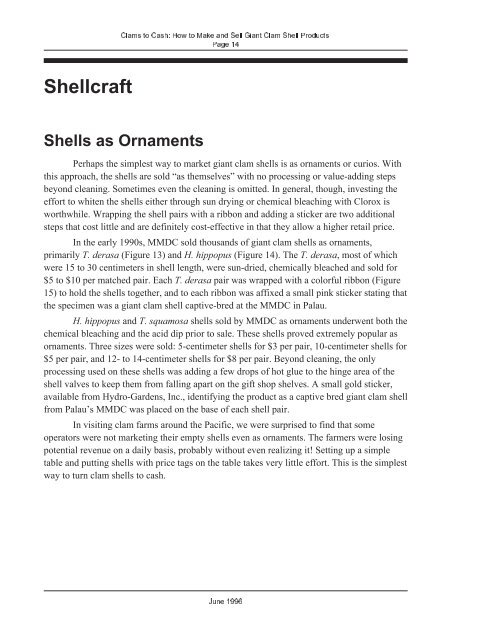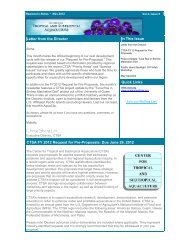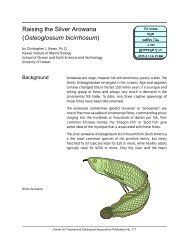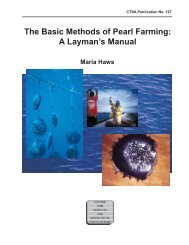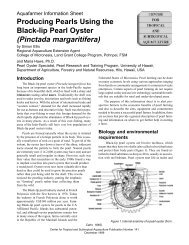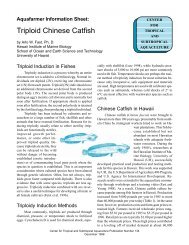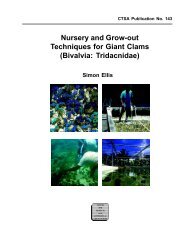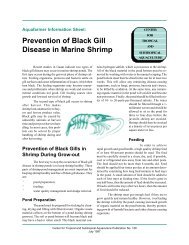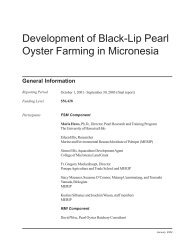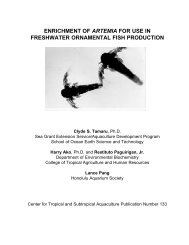Clams to Cash: How to Make and Sell Giant Clam Shell ... - eXtension
Clams to Cash: How to Make and Sell Giant Clam Shell ... - eXtension
Clams to Cash: How to Make and Sell Giant Clam Shell ... - eXtension
- No tags were found...
You also want an ePaper? Increase the reach of your titles
YUMPU automatically turns print PDFs into web optimized ePapers that Google loves.
<strong><strong>Clam</strong>s</strong> <strong>to</strong> <strong>Cash</strong>: <strong>How</strong> <strong>to</strong> <strong>Make</strong> <strong>and</strong> <strong>Sell</strong> <strong>Giant</strong> <strong>Clam</strong> <strong>Shell</strong> ProductsPage 14<strong>Shell</strong>craft<strong>Shell</strong>s as OrnamentsPerhaps the simplest way <strong>to</strong> market giant clam shells is as ornaments or curios. Withthis approach, the shells are sold “as themselves” with no processing or value-adding stepsbeyond cleaning. Sometimes even the cleaning is omitted. In general, though, investing theeffort <strong>to</strong> whiten the shells either through sun drying or chemical bleaching with Clorox isworthwhile. Wrapping the shell pairs with a ribbon <strong>and</strong> adding a sticker are two additionalsteps that cost little <strong>and</strong> are definitely cost-effective in that they allow a higher retail price.In the early 1990s, MMDC sold thous<strong>and</strong>s of giant clam shells as ornaments,primarily T. derasa (Figure 13) <strong>and</strong> H. hippopus (Figure 14). The T. derasa, most of whichwere 15 <strong>to</strong> 30 centimeters in shell length, were sun-dried, chemically bleached <strong>and</strong> sold for$5 <strong>to</strong> $10 per matched pair. Each T. derasa pair was wrapped with a colorful ribbon (Figure15) <strong>to</strong> hold the shells <strong>to</strong>gether, <strong>and</strong> <strong>to</strong> each ribbon was affixed a small pink sticker stating thatthe specimen was a giant clam shell captive-bred at the MMDC in Palau.H. hippopus <strong>and</strong> T. squamosa shells sold by MMDC as ornaments underwent both thechemical bleaching <strong>and</strong> the acid dip prior <strong>to</strong> sale. These shells proved extremely popular asornaments. Three sizes were sold: 5-centimeter shells for $3 per pair, 10-centimeter shells for$5 per pair, <strong>and</strong> 12- <strong>to</strong> 14-centimeter shells for $8 per pair. Beyond cleaning, the onlyprocessing used on these shells was adding a few drops of hot glue <strong>to</strong> the hinge area of theshell valves <strong>to</strong> keep them from falling apart on the gift shop shelves. A small gold sticker,available from Hydro-Gardens, Inc., identifying the product as a captive bred giant clam shellfrom Palau’s MMDC was placed on the base of each shell pair.In visiting clam farms around the Pacific, we were surprised <strong>to</strong> find that someopera<strong>to</strong>rs were not marketing their empty shells even as ornaments. The farmers were losingpotential revenue on a daily basis, probably without even realizing it! Setting up a simpletable <strong>and</strong> putting shells with price tags on the table takes very little effort. This is the simplestway <strong>to</strong> turn clam shells <strong>to</strong> cash.June 1996


